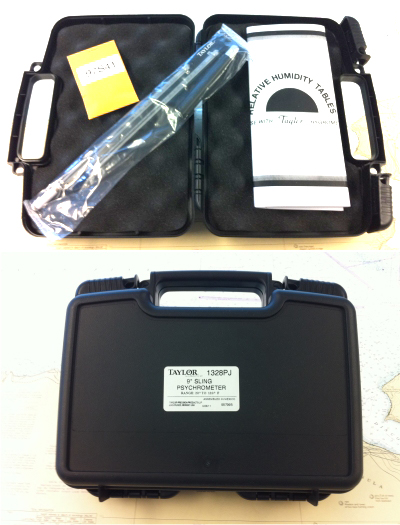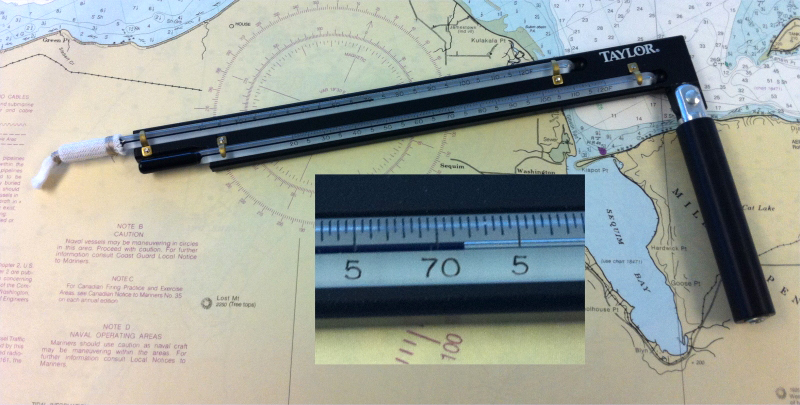Relative humidity (RH) is a tricky measurement, primarily because it is so sensitive to the air temperature. One of the most basic measurements of RH is also one of the least expensive, namely a sling psychrometer. It has two identical thermometers one that remains dry (dry bulb) and the other covered by a clean cotton wick that is made wet with clean fresh water. Both are mounted on a swivel that can be swung about for the purpose of increasing the rate of evaporation of water on the wick.
Since the process of evaporation takes energy it cools the water, wick, and the thermometer inside it as the water evaporates; the more the evaporation, the more the cooling. But there is a limit, and that limit depends on the evaporation rate and that rate depends on the relative humidity of the air that is being evaporated into. Thus the suppression of the wet bulb thermometer temperature compared to that of the dry bulb thermometer is a measure of the relative humidity of the air at the dry bulb air temperature.
We have tested several of the these Taylor units. They are well made and a nice compromise in price, size, and accuracy. The list price is about $180 these days, but generally you can find them notably less... and I have seen then on eBay called new for well under $100.
Range 20°F to 120°F
9" Permacolor™ filled thermometers
Temperature accuracy ± 0.2°
Folding swivel handle
Hard plastic protective case (about a 12 " wide)
6 replacement wicks
The instrument is used by wetting the clean
wick with distilled water, then swirling it around for about 30 seconds
or more (rather vigorously) and then reading the wet bulb and dry bulb temperatures. With these
values you can look in tables (included with the device) to learn the
dew point of the air and its relative humidity.
Or go to this link to find both RH and dew point from the two temperatures: www.starpath.com/calc. Dew point is of more interest to navigators as it tells us how far we are from fog, whereas RH is of more interest to human comfort and how other things like violins and cigars interact with the atmosphere. Also for optimum espresso you have to change your grind number by 1 or 2 with RH changes between say 40 and 70.
By plotting dew point and temperature as a function of time you can
often predict when fog will form. Accurate sling psychrometers like
these can also be used to calibrate hygrometers that read the relative humidity directly on a dial.
Here is a quick test of 4 Taylor units showing the dependability of the
thermometers. The wet and dry bulb temperatures should be identical for
all units on a given time when sitting side-by-side at rest, out of
breezes, and on a uniform temperature base. Also keep in mind looking at
the dial, that tenths of a degree must be estimated. These were read
using a magnifying glass, being careful to avoid parallax errors, and
being careful to not get so close to the thermometer that radiant heat
from your own body does not change the reading, which is a real concern, because the result is sensitive to tenths of a degree. Clearly they are
all well within the specs given by Taylor. This is a crucial condition,
because the accuracy of the humidity and dew point results are a direct
computation from the temperature data. (Unit 4 was sold on Day 2.)
We only have these data at this temperature, but from this the instruments look good, and we have used our in-house model for several years.
A few related, random notes:
(1) There are devices like this that have reservoirs for the wick water and fans that blow on the dial (ie do not have to swing them) and some have even more accurate thermometers. These are called Assmann aspiration psychrometers. Good ones cost $1000 to $1500. These units can get RH to about 2%.
(2) RH can be measured directly, either electronically or mechanically (based on the fact that how much human hair stretches depends on the RH).
(3) Electronic units that read RH directly and cost less than $100 or so, probably do not work.... ie compare 5 or 6 side by side and they will differ by 20 to 40%. Even ones that cost $1,000 have to be calibrated every year or so.
(3) Hair hygrometers can be human hair (works all temperatures) or synthetic hair, works above freezing. The Fischer Precision Instrument Company that is famous for high quality barometers receives the same high esteem worldwide for their hair hygrometers. Synthetic hair takes less maintenance. Always get a matching thermometer to sit beside it as you must know both numbers to do anything with the results. ie, to say the RH is 40% does not tell you much about the conditions of your atmosphere without knowing what temperature that was. Fisher hair hygrometers (model 122.01) cost about $60 and yield about 3-5% accuracy... all such instruments must be calibrated at some point. Matching thermometer (model 117.01) costs about $40.
(5) I must also add that we have not tested less expensive sling psychrometers. It could be that some that cost much less will also do the job. They key issue is are the thermometers identical and how accurate can you read them. In principle you could make your own from two thermometers and just blow a fan on them. We have done that with our Taylor and that works fine.... if not better than slinging it around. The wicks are easy to find online. You might call that one a half-Assmann model.
In short, a device like the Taylor model above is a good solution to many needs for accurate RH... or as a way to calibrate a good hair hygrometer.



1 comment:
Just a general question does permacolor have mercury in it? Or what are the ingredients used inside the filling?
Post a Comment